Home / Resources
Resources
Discover a Wealth of BPM Knowledge and Expertise at BPMInstitute.org!

Architecting Enterprise Business Model
This is the second in a series of eight articles that should see the light of day on both BPMInstitute.org and SOAInstitute.org during 2009. It looks to the author like the perfect opportunity to build a profound methodological case for two fundamental parts of the modern Enterprise Development Methodology (EDM): Enterprise Architecture & Processes. The first such article, making the basic case for EDM, was just recently published on SOAInstitute.org1 .

Achieving Business Agility with SOA
You would think that for many SOA evangelists and practitioners the current challenging business climate would be the perfect opportunity to walk the walk on the main promise of SOA – business agility. Agility is defined as: “Nimbleness in the face of unexpected obstacles”. Well, we certainly have a whole bunch of those at the moment.
Although the vendors are pushing this value proposition heavily at the moment, the take-up is still hampered by a lack of real business success stories. And, of course, lack of budget.

“Bootstrapping” Your Company’s Productivity Program
Introduction:
You’ve just been asked by your boss to develop and implement a productivity program to reduce waste and improve quality. Several of the executives are retrenching into a defensive posture: preserve cash, freeze discretionary spending, cut operating budgets X% across the board, accelerate early retirements, layoffs, and sell off non-core assets. Others are advocating more investment in R&D, rolling out new products / services, and even rethinking the business model. Your company’s livelihood is at stake. The expectations for you personally are even higher.

Process Ownership and Governance; Paradigm Shift
After 3 decades of Total Quality Management, Process Reengineering, Lean, Six Sigma and now Business Process Management, it is mind boggling to observe that only a few companies have an excellent process Governance in place and consistently manage their processes.
It is certainly valid to ask ourselves why we are not doing better and what can we do to remediate to the situation. The literature from the ABPMP BPM CBOKTM to the different Gartner reports and our understanding of process ownership and governance has certainly improved tremendously over the last 5 years and yet we still count only a few companies that manage by process year after year.
After pondering the question for a while here are a few thoughts on the question and some suggestions on how to approach Governance and Ownership in a way that can lead to better results and a sustainable process culture.

The Dilemma of BPM
There are few business professionals today who do not know what Business Process Management is or do not have, at least a general idea of what it’s about. The number of articles and papers being written about BPM has increased at a rapid pace over the past five years to the point one cannot open a business magazine or newsletter without some reference to the tools and technologies that are available to make your organization truly process-centric.

Secret to Becoming a Lean/Agile Enterprise: Leaders Acting Well Together
Much of the discussion about collaborative methodologies like Lean, Agile and Design Build has, in the past been about creating continuous flow of value, team dynamics, technical practices and even the project management techniques required to get effective and acceptable products delivered and/or deployed. What teams in all environments quickly find out, however, is they are dependent on other organizational dynamics outside their purview, like securing customer involvement, issue escalation, resource allocation, even facility management becomes important.

BPMS Watch: Five Things to Love About BPMN 2.0
BPMN 2.0 is almost here. If all goes as planned, it will be voted on by OMG members in June. Assuming it passes, that doesn’t mean BPMN 2.0 is officially adopted and available in commercial tools, just that it has entered the “finalization” phase when tool vendors can start building it in. Even though the diagram notation of BPMN 2.0 appears little changed from previous versions, it represents a big step forward.
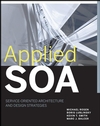
Book Review – Applied SOA: Service-Oriented Architecture and Design Strategies
There is no shortage of books that cover SOA topics, but few of them go beyond background information, telling us what a service is and what technologies we can use to network them, but leaving us on our own to figure out how to identify or design a service. Fewer still go into the design of SOA solutions for the enterprise. I’m happy to report that this book is a welcome exception.

The Maturity Level of a Process as a Principle Factor for Process Automation (First Pillar)
“A high level of process maturity is considered a fundamental pillar for comprehensive process automation and successful future implementation. The process operation and the time this process has been utilized by the business must be well understood by the person or people who are going to automate said process. Considering implementing a theoretical process or a process that possesses a low level of maturity is likely to result in failure and/or extended execution time and/or a high investment in cost and resources.

Aligning Strategy & Execution
Strategy [strat’-i-jee]: a plan, method or series of maneuvers or stratagems for obtaining a specific goal or result. Execute [ek’-si-kyoot]: to produce in accordance with a plan or design. Clearly, the two ideas are closely related; one involves setting a plan and the other involves putting the same plan into motion. Simple enough. Yet, why is it that so many companies fail to make the connection?
In my experience, most organizations are very adept at planning.
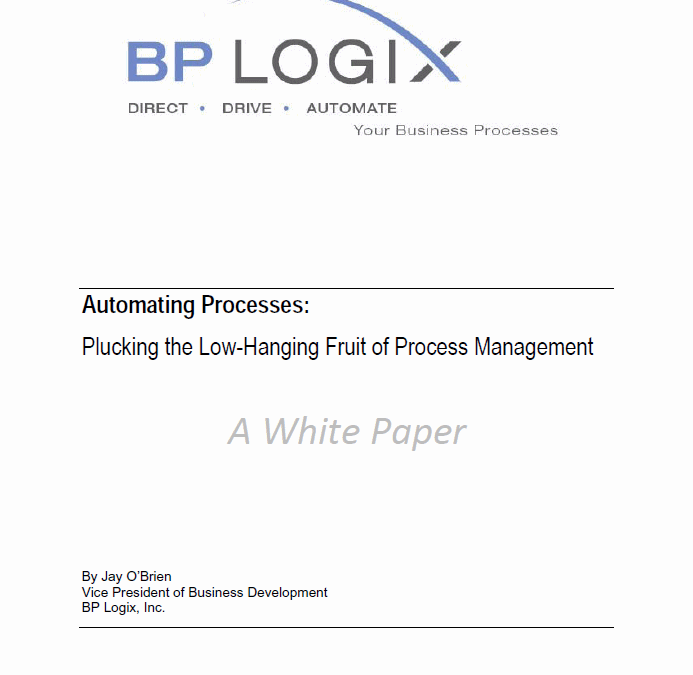
Automating Processes: Plucking the Low-Hanging Fruit of Process Management
Business Process Management can conjure up images of tremendous complexity, months of planning, committees, meetings, boxes, arrows and squiggles depicting business processes. While BPM can be that complex, it needn’t be. You can move, and quickly, to pluck the low hanging *process automation) fruit for your company. This white paper offers some guidance, things to ponder, consider and act on as you contemplate how to automate your business processes.

The Essence of Business Architecture
There continues to be confusion over the practice of business architecture and the role of the business architect. One way to clear this up is to examine other forms of architecture and the related role of the architect. First, we should restate the industry definition.
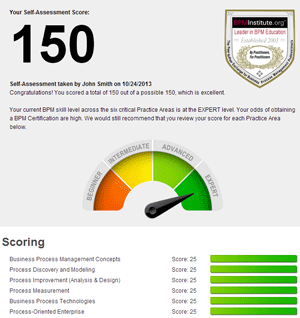
BPM Skills Self-Assessment
Aspiring and veteran BPM practitioners alike can use this self-assessment to determine current strengths and weaknesses across six critical Practice Areas. It will also help you determine your odds of obtaining a BPM Certification.
Please note: The assessment has been updated and is no longer presented as a webcast. Please visit the link below to take the assessment.
Are you just getting your feet wet in Business Process Management and want to know where to start? Do you have some experience but want formalized training?
BPMInstitute.org’s training program may be the right choice for you.
Training is essential to maintain your edge and get ahead in today’s difficult economic times. It’s becoming more and more important to differentiate. Becoming a process thinker will allow you to achieve both of these objectives. With so many BPM course options, what is a fast and efficient way to find out where to begin?
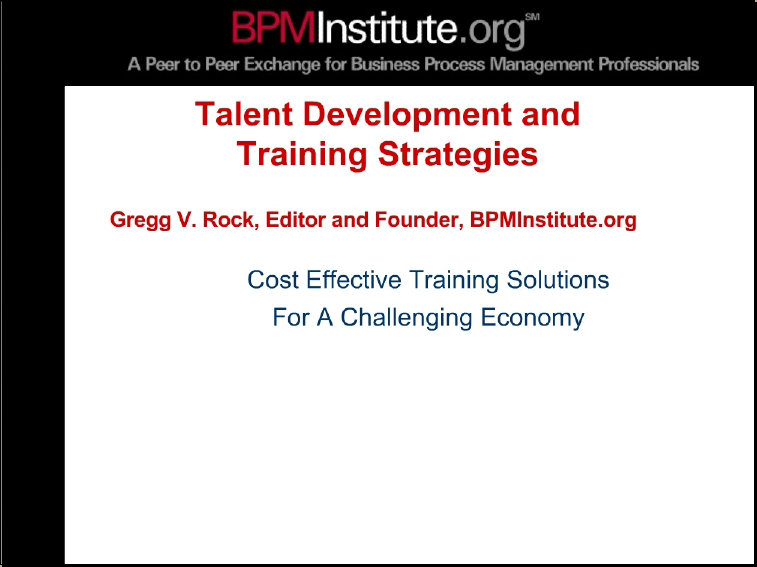
Talent Development and Training Strategies: Cost Effective Training Solutions For A Challenging Economy
Does your staff need training… Are looking to spread BPM education throughout your company…Are you considering a continuous process improvement initiative…but you have the “can’t travel” budget blues?
Join BPMInstitute.org’s Founder & Editor, Gregg Rock, for an executive overview of cost-effective Training strategies already being employed by other members.
During this Round Table, you will learn how to:
- Provide training for your staff at a fraction of the cost of traditional Face-to-Face training
- Increase your employees options for receiving the training needed to become mo
Does your staff need training… Are looking to spread BPM education throughout your company…Are you considering a continuous process improvement initiative…but you have the “can’t travel” budget blues?

Doing More with Less
Today’s challenge to increase productivity with fewer resources has lead to numerous methodologies and toolkits to help organizations meet their objectives and become more profitable and effective. This certainly makes the case for applying two well known and proven methodologies Business Process Management (BPM) and Six Sigma.
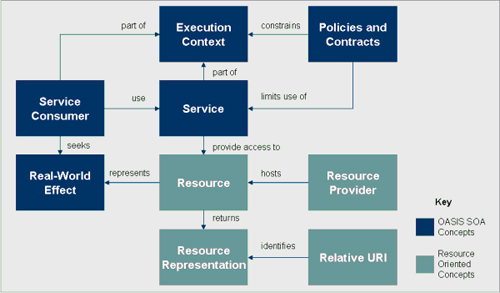
Resource Oriented Architecture
According to a 2008 Gartner Survey1 there has been an increase in the number of organizations implementing web services using Representational State Transfer (REST) and Plain Old XML (POX).

Reviews: Necessary Evil or Symptom?
During any BPMS demo, the vendor will demonstrate how the application handles the review and approval cycle of some work product, e.g., a document, form, or report. Review and approval of these products is a process cycle that all businesses share, and in my opinion, one that’s entirely too common. Reviews aren’t disappearing anytime soon. They are in some cases a necessary evil. However, let’s be clear – reviews aren’t value added activities.

Collaboration and Business Decision Management
Business Rule Management Systems (BRMS) have been described as the ultimate platform to achieve true collaboration. By bridging the gap between business and technology, two previously disparate groups that did not speak the same language could now do so in the universal language of business rules. And to a certain extent these systems met that goal. However, there have been persistent nagging issues centered around things like requirements and change management that seem to keep getting in the way of collaboration and, ultimately, true agility.

Process Management Scenarios and their Technology Requirements
One of the interesting BPM debates I’ve been following in the past months has been about the relevance of BPM technology standards such as BPMN and BPEL (with some protagonists claiming that BPEL isn’t powerful enough as a modelling or implementation language to express the richness of some processes; and others claiming that in fact it’s just fine – for example, see the online debate between Keith Swenson and Ismael Ghalimi.

BPM and Software as a Service
Today’s economic pressures are resulting in an increasing scrutiny on IT budgets and how to achieve the best return on investment. IT project portfolios are constantly evaluated by the CIOs in light of new budgets and constraints. Clearly IT spending is on the fall, significant budgets cuts are on way, and new initiatives are impacted. BPM initiatives that had initially made their way into the portfolio are now being re-evaluated given the upfront capital cost of procuring Hardware and software.













